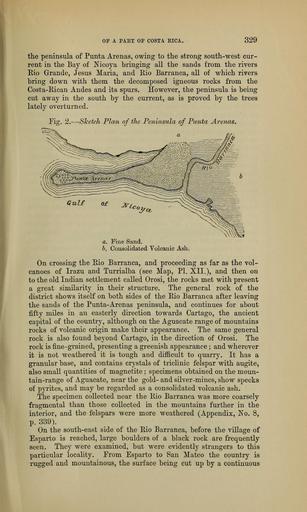MAKE A MEME
View Large Image

| View Original: | The_Quarterly_journal_of_the_Geological_Society_of_London_(13860231484).jpg (1233x2056) | |||
| Download: | Original | Medium | Small | Thumb |
| Courtesy of: | commons.wikimedia.org | More Like This | ||
| Keywords: The Quarterly journal of the Geological Society of London (13860231484).jpg OP A PART OP COSTA EICA <br> 329 <br> the peninsula of Punta Arenas owing to the strong south-west cur- <br> rent in the Bay of Nicoya bringing all the sands from the rivers <br> Rio Grande Jesus Maria and Rio Barranca all of which rivers <br> bring down with them the decomposed igneous rocks from the <br> Costa-Rican Andes and its spurs However the peninsula is being <br> cut away in the south by the current as is proved by the trees <br> lately overturned <br> Fig 2 ” Sketch Plan of the Peninsula of Punta Arenas <br> a Fine Sand <br> b Consolidated Volcanic Ash <br> On crossing the Rio Barranca and proceeding as far as the vol- <br> canoes of Irazu and Turrialba see Map PI XII and then on <br> to the old Indian settlement called Orosi the rocks met with present <br> a great similarity in their structure The general rock of the <br> district shows itself on both sides of the Rio Barranca after leaving <br> the sands of the Punta- Arenas peninsula and continues for about <br> fifty miles in an easterly direction towards Cartago the ancient <br> capital of the country although on the Aguacate range of mountains <br> rocks of volcanic origin make their appearance The same general <br> rock is also found beyond Cartago in the direction of Orosi The <br> rock is fine-grained presenting a greenish appearance ; and wherever <br> it is not weathered it is tough and difficult to quarry It has a <br> granular base and contains crystals of triclinic felspar with augite <br> also small quantities of magnetite ; specimens obtained on the moun- <br> tain-range of Aguacate near the gold- and silver -mines show specks <br> of pyrites and may be regarded as a consolidated volcanic ash <br> The specimen collected near the Rio Barranca was more coarsely <br> fragmental than those collected in the mountains further in the <br> interior and the felspars Avere more weathered Appendix No 8 <br> p 339 <br> On the south-east side of the Rio Barranca before the village of <br> Esparto is reached large boulders of a black rock are frequently <br> seen They were examined but were evidently strangers to this <br> particular locality From Esparto to San Mateo the country is <br> rugged and mountainous the surface being cut up by a continuous 36936122 113692 51125 Page 329 Text 38 http //www biodiversitylibrary org/page/36936122 1882 Geological Society of London NameFound Nicoya NameConfirmed Nicoya EOLID 12168282 NameBankID 4567178 NameFound Turrialba NameConfirmed Turrialba NameBankID 5142375 Biodiversity Heritage Library The Quarterly journal of the Geological Society of London v 38 1882 Geology Periodicals Smithsonian Libraries bhl page 36936122 dc identifier http //biodiversitylibrary org/page/36936122 smithsonian libraries Information field Flickr posted date ISOdate 2014-04-15 Check categories 2015 August 26 CC-BY-2 0 BioDivLibrary https //flickr com/photos/61021753 N02/13860231484 2015-08-26 07 52 51 cc-by-2 0 PD-old-70-1923 The Quarterly journal of the Geological Society of London 1882 Photos uploaded from Flickr by Fæ using a script | ||||